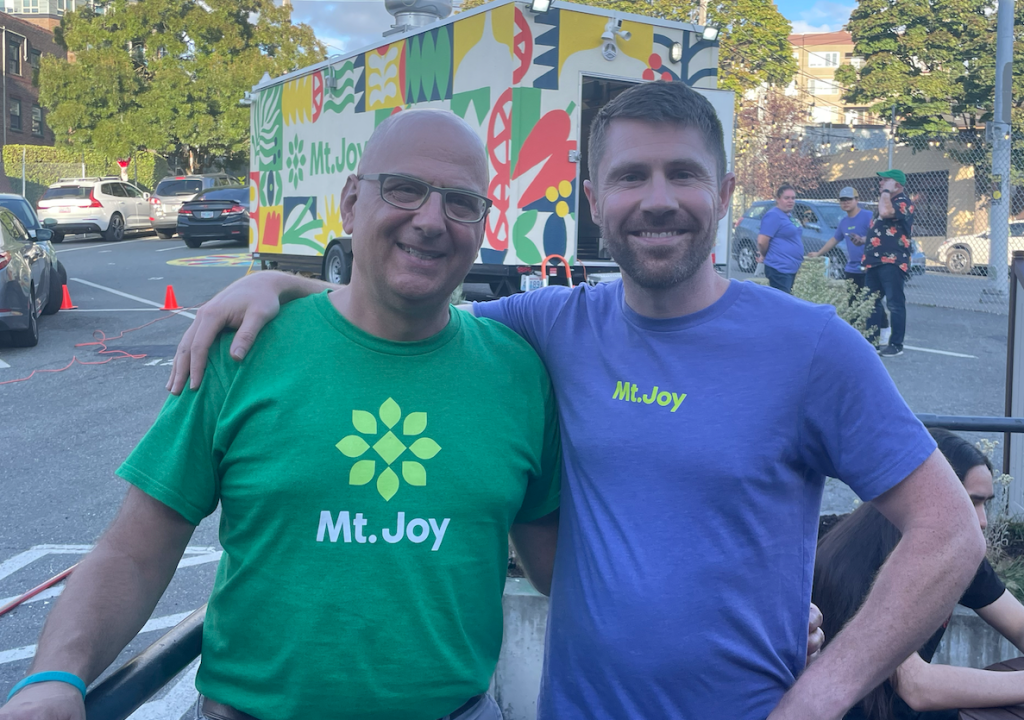This week, Seattle-based regenerative restaurant chain Mt. Joy announced it’s opening its second location in the Capitol Hill neighborhood of Seattle. The new location – Mt. Joy’s first brick-and-mortar location after opening a food truck this fall – will be nestled next to Seattle’s only Sweetgreen on the corner of 11th and Pine in a brick building formerly home to the Stout Brewery.
A new restaurant opening usually doesn’t cross our radar, but what makes this one particularly interesting is the grandiose vision of its founder, Robbie Cape. Cape, who made a name for himself first at Microsoft and then as CEO and cofounder of health tech startup 98point6, has plans to open a nationwide chain of tech-forward regenerative chicken sandwich shops. While several big restaurant chains have made small moves to burnish their regenerative bonafides (small enough that some have labeled these efforts a new form of greenwashing), Cape has made it clear that his chain – and especially his chicken – will be built entirely around hyperlocal, extremely transparent regenerative sourcing practices.
“When I say regenerative to every component of the supply chain and bringing joy to all the constituents, I really do mean it,” Cape said when The Spoon sat down with him this September at his food truck opening. “And I know it’s audacious. And I know we’re not going to get it right on every one all the time. But we’re going to try, and we’re going to keep trying to get better.”
Cape knew when he came up with the idea that creating a fully regenerative-focused chicken sandwich chain would be a heavy lift, particularly for someone without any previous restaurant experience. Because of this, he started cold-calling restaurant folks, including Seattle-famous chef and restaurateur Ethan Stowell, to soundboard the idea.

Above: Mt. Joy CEO Robbie Cape with Company’s Chief Agricultural Officer, Grant Jones
“The first lesson that I learned when I was starting to get feedback from people in the restaurant business about this cockamamie concept that I had around building a restaurant around regenerative is the food has to be great. Someone told me, ‘You got to know Robbie, no matter how good this story is, it won’t matter unless the food is the best,'” said Cape. “And so that was one of the reasons I set out to try to meet Ethan Stowell, which was not easy. He’s a celebrity, and I didn’t know that I had any connection to him. It turns out I do. But I reached out via the ‘Contact Us’ form on his website.”
As it also turns out, Stowell liked the idea and came on as cofounder (as would Stowell’s former executive pastry chef, Dionne Himmelfarb, who ran point on designing Mt Joy’s menu). Once Cape had his chef(s) on board, he set about building the rest of the team, including bringing on a marketing person, a farmer with experience in regenerative farming practices, and a tech person. Surprisingly, for a tech entrepreneur, it was this last hire – chief technology officer – that Cape initially had the most reservations about.
“I sat down with Ethan and said, ‘I’m a little reticent about raising this with you, but I think that we need a technologist on the founding team because we want to build a new way of interacting with the restaurant.’ So I started to pitch it like, ‘I think we need a technologist,’ and Ethan’s like, ‘Robbie, absolutely, we do. 100%.'”

And it’s this part of the Mt. Joy equation – the customer interaction piece – where Cape’s (and CTO Justin Kaufman‘s) technology background shines through. When I visited Mt. Joy’s food truck installation in the fall, there was a QR code that showed me the way to the app, and once I ordered my chicken sandwich and fries, I got a text notifying me when my food was ready.
That’s all pretty standard stuff nowadays, but Cape sees the digital order flow as a way to create new and interesting personalized experiences tailored around preferences and past order history.
“When you come to restaurants, they never know who you are,” Cape said. “They don’t know what you ordered last time. They forget about you, like every time it’s new. When you go to Google, Google knows you. When you go to Apple, they know you. We need to know you.”
While I wasn’t as convinced by Cape’s belief that he could differentiate around digital ordering interfaces as he was, I figured he and his CTO would develop some interesting ideas. However, I was convinced about his effort to source every single ingredient through local farmers and food companies, something which was already evident in the menu. Every ingredient listed the source and the mileage it had traveled before being put on the menu. About the only thing that traveled over a hundred miles were spices like paprika which aren’t grown in the Seattle market.
Cape wasn’t flustered when I told him his list of sources for each ingredient was impressive, but replicating it beyond Seattle would require rebuilding the supply chain in each new market.
“It’s true, it’s hard, a little more expensive, but it’s mostly like that’s an intellectual game,” said Cape. “So you have a team who’s going to have to really be thinking about sourcing, and we’re gonna have to build these relatively local supply chains. But as it turns out, there’s a lot of products. There are a few areas where we might have a few challenges, and our answer to that is we’ll be transparent.”
If you’re in the Seattle market and want to find out what a fried chicken sandwich sourced from regenerative farming practices tastes like, you can visit Mt. Joy’s newest location starting December 1st.


